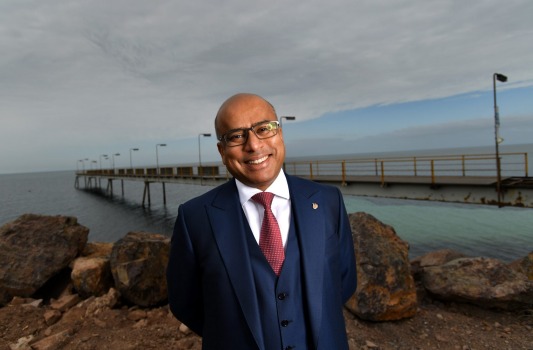
Here are the last four feature articles from Giles Parkinson at RenewEconomy (as of last weekend):
- Coalition votes to kill renewables, encourage new coal generation
- Gupta launches 1GW renewable plan at Cultana solar project
- Gupta: ACCC underwriting idea may help slash solar costs to $20s/MWh
- South Australia will be at 100% renewables by 2025 – market operator
It’s quite likely that politicians don’t read RenewEconomy. Here’s Ben Potter in the last Weekend AFR:
Potter says:
- Move over coal-power champion Trevor St Baker – British billionaire Sanjeev Gupta wants to crash the Turnbull government’s “NEG-plus” coal party and use an underwriting mechanism proposed by the Australian Competition and Consumer Commission to build cheaper solar farms.
Here’s the deal on offer:
- The proposal – government underwriting for any form of dispatchable (or firm) new power for 10 years at a low price of $45-50 per megawatt hour – does not specify coal or any type of fuel. Most experts consider it will not underwrite investments in new coal-fired power plants, which have a minimum cost of power of $80 per megawatt hour and need to run for at least 40 years to repay its investors at commercial rates.
If it takes seven years to build a coal-fired power station, and the 40 years to get a return, who thinks coal-fired power stations will run to 2065? No responsible financier would take the risk.
An opportunity presents itself to make firmed solar eligible for the scheme, and thus near-government interest rates:
- Mr Gupta has told Reneweconomy he believes the underwriting mechanism could help slash the cost of solar power in Australia to below $30/MWh and the cost of firm solar power – solar power backed by gas or storage to make it dispatchable – to $40-$50/MWh or “half what we pay now”. He said the price of energy for big industrial consumers – which soared above $100/MWh last year after the closure of the Hazelwood coal power station, could be brought back to historical levels of around $50-$60/MWh.
Currently however:
The mechanism is also dependent on major energy customers not being able to get contracts to cover their needs, a contingency the Australian Energy Market Operator does not see arising for a decade unless there is an early closure of another large power station. (Emphasis added)
Another Turnbull government scheme that will do nothing?
If Turnbull truly had a ‘laser-like focus on price’ he would adopt this scheme for renewables in a heart beat. However, perhaps the mere existence of the scheme may bring interest rates charged for new renewables down somewhat. Certainly, if Turnbull gave up his technology neutral nonsense and favoured technologies that are good for the planet, firmed renewables could become very cheap indeed.
The ‘technology neutral’ mantra used by the Turnbull government neglects to count the cost to the planet and life upon it of dumping CO2 and methane in the atmosphere.
In any case now, the Gupta development indicates that NEG may not bring the development of renewable to a halt.
Potter notes that other companies are in the business, including Genex, which is developing a $1 billion solar and pumped hydro project in north Queensland.
The second Parkinson article above, of 15 August, says:
-
UK steel billionaire Sanjeev Gupta has officially launched his plans to build more than 1 gigawatt (1,000MW) of dispatchable renewable energy at a ground-breaking ceremony for the first of those projects – the 280MW Cultana solar project near Whyalla.
It goes on to quote Gupta:
“Today’s event is symbolic of our desire to develop and invest in new‐generation energy assets that will bring down Australia’s electricity prices to competitive levels again, as well as our commitment to local and regional Australia,” Gupta said in a statement released before the ceremony.
“In particular, this signals the beginning of our journey with a number of stakeholders to not only transform GFG’s operations in Whyalla, but also further enhance the appeal of this great city.”
Gupta bought the Whyalla steelworks and other OneSteel assets in the eastern states late last year, and immediately announced his plans to transform the business by building and contracting large-scale solar and energy storage, even highlighting plans to build as much as 10GW across Australia to create a “solar-based” economy.
Already, he has signed a contract to power much of the Laverton steelworks with a new solar farm in Victoria, and several other contracts to supply other major energy users in South Australia.
The Cultana solar farm, which is due to begin formal construction early next year, is the first of a number of projects planned for the area,.
These include a second stage of the solar farm, what would be the world’s biggest lithium-ion battery (120MW/140MWh), a major pumped hydro project in dis-used iron ore mines in the nearby Middleback Ranges, and co-generation at the steelworks themselves.
Gupta’s plan to power the steelworks in South Australia, Victoria and NSW – and the new solar farm built by Queensland zinc refiner Sun Metals – contrasts with the position of other manufacturers like Bluescope and Tomago, who insist that renewables could only play a minor role in their power supply, and that they need new “baseload.” (Emphasis added)
In the third Parkinson article Gupta says there are similar schemes of low-cost finance schemes to promote renewables in the UK, but Australia could get solar costs down below those of the Middle East because Australia has a much better solar resource.
-
Gupta’s Simec Zen Energy has already contracted to supply the South Australia government, and recently did the same with half a dozen businesses that pooled their energy needs through a tender conducted by the South Australia Chamber of Commerce and Mines.
The majority of these electricity demands will be met through renewables, such as with solar farms contracted in the eastern states, and financial contracts, and then with the solar and storage capacity that will be built over the next few years in South Australia.
Moreover:
- Gupta also confirmed his intention to establish a manufacturing plant of “low cost” electric vehicles in Australia, although he said he had nothing new to announce on the site location.
Gupta hopes to be in production in 2-3 years.
Parkinson also links to David Leitch’s article Any new coal generator will force the early closure of another>
The chief reason seems to be that, risks of increased targets and stranded assets aside, the NEG as presently framed does lock in the gradual reduction of emissions over the decade. Under the NEG the onus is on the retailers. So unless Turnbull changes what has been served up, any new coal can only replace old coal.
Parkinson’s fourth article begins by looking at the AEMO’s (Australian Energy Market Operator) Integrated System Plan (ISP) and what it forecasts about renewables in South Australia. The forecast is for SA to reach 100% renewables by 2025. This graph of electricity sources has been compiled by Dylan McConnell from ISP data:
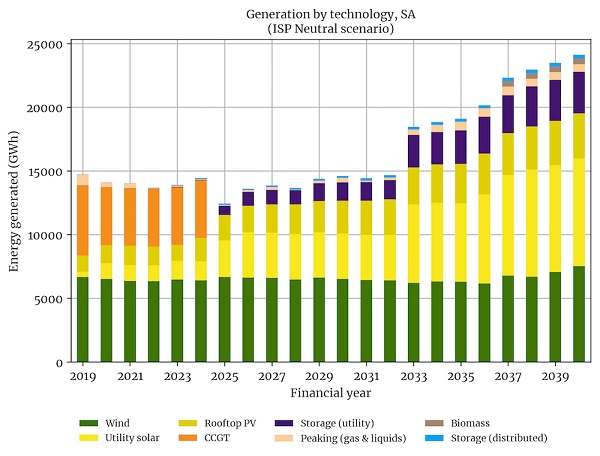
Notice that gas disappears to be replaced by utility storage, although some peaking gas appears thereafter. The other notable feature is the swing from wind to solar, both utility and rooftop.
McConnell says:
- “The ISP suggest that a combination of deeper interconnection and other options such as synchronous condensers are a cheaper option than maintaining gas generation, given that AEMO uses a least-cost engineering optimization approach.”
Hugh Saddler wrote a detailed appraisal of the ISP for The Australia Institute showing the states’ progress on renewables:
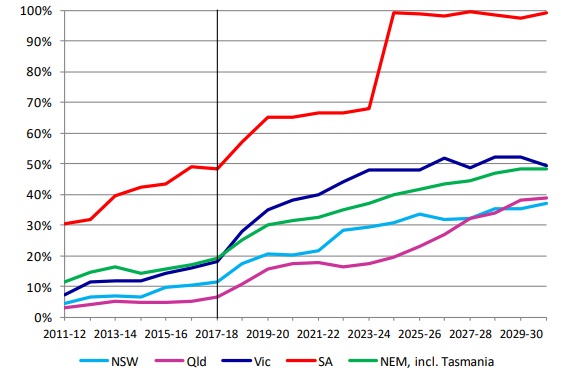
Victoria does well, NSW not so well. However, the NEM could reach more than shown on the graph. The ISP says 46 to as much as 60 per cent. That is without the NEG
However, AEMO now has a requirement for a minimum level of synchronous generation to remain online in South Australia at all times, which needs the Heywood interconnector to Victoria, although I understand the big battery helps. A priority in AEMO’s ISP is a new high-capacity synchronous interconnector, called RiverLink, to run from the mid north of South Australia to southern New South Wales and be completed by 2025. If that is completed the picture is altered to this:
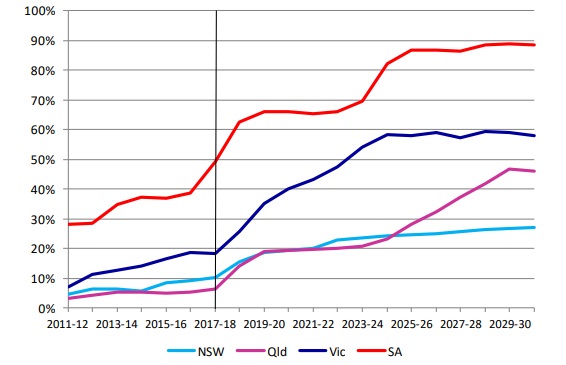
Reported almost nowhere other than at RenewEconomy (I heard it on ABC radio) The COAG meeting instructed the ESB to come up with an action plan by December on how the first phase of AEMO’s ISP recommendations on transmission and interconnection can be put in place, and also come up with suggestions on how the Group 2 recommendations can also be progressed. (See meeting outcomes. They had a briefing on hydrogen, should have but didn’t have one from Prof Blakers on pumped hydro, which is starting to enter the common lexicon.)
This post was mostly written before Monday 20 August. That day brought an article in the AFR by Angela Macdonald-Smith about industry increasingly entering power purchase agreements (PPAs) locking in a commitment to green power. This graph shows the price trend:
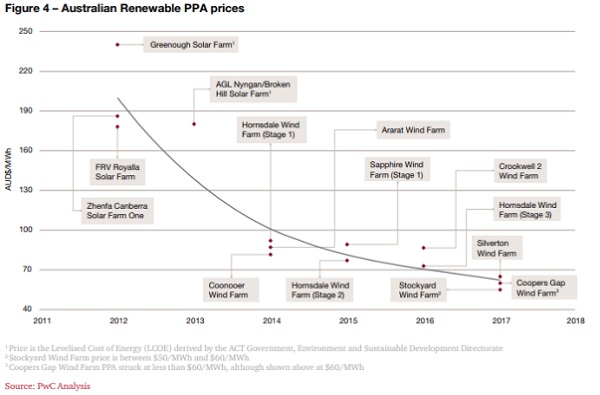
It is quite evident that the states and business are proceeding to transition to renewable energy, irrespective of Canberra’s deranged circus of wreckers [who] are now writing our future.
Sadly, Monday 20 August will go down as the day of infamy for PM Malcolm Turnbull, who claimed in 2009 that he would “not lead a party that is not as committed to effective action on climate change as I am”.
We can’t see it, but I think it is written in stone in the Coalition agreement that the Nationals will have last say on climate change. Deputy Nats leader Bridget McKenzie made the party’s attitude clear:
-
“I am not afraid to say the c-word, coal, coal, coal,” so says National deputy leader Bridget McKenzie.
And:
“It’s going to be one of those areas that we are going to invest in,” McKenzie said. “It’s not going anywhere in the short term.”
In any case Turnbull has made it manifestly clear that every single person in the joint party room has to be accommodated rather than seek consensus with Labor.
And to top this off, the Coalition is also speaking of financing the refurbishment of existing coal-fired generators, to ensure they stay on line, and to force the sale of those assets companies like AGL are threatening to close.
“We back him 100 per cent,” said McCormack said in relation to coal entrepreneur Trevor St Baker’s interest in building a new coal-fired generator.
David Spratt and Ian Dunlop have a piece in The Guardian Politicians must set aside blinkered ideologies in the climate endgame wherein they announce that they have published their critique of climate change science What lies beneath.
Mainstream science is too conservative and underplays the issue of existential risk from lower-probability, but higher-impact events which would be devastating for human societies. (Martin Weitzman has been warning about this since 2008.)
-
A reframing of scientific research within an existential risk-management framework is urgently required, both in the work of the IPCC and in UN climate negotiations. Current processes will not deliver either the speed or the scale of change required.
In the foreword Hans Joachim (John) Schellnhuber, one of the world’s leading climate scientists (he hangs out at the Potsdam Institute and advises Angela Merkel):
-
says that the issue now “is the very survival of our civilisation, where conventional means of analysis may become useless” and that “climate change is now reaching the endgame, where very soon humanity must choose between taking unprecedented action, or accepting that it has been left too late and bear the consequences”.
Malcolm Turnbull has chosen the smell of ministerial leather and temporary political power over the future of the planet and of humanity.
They used to tell us that Turnbull was always the smartest bloke in the room. He knows what he is doing.

Brian,
National deputy leader Bridget McKenzie says:
And:
And yet Jim Barry at BlackRock says:
I know who I would take more notice of.
Brian,
You refer to David Leitch’s article Any new coal generator will force the early closure of another, dated Aug 16. It includes an analysis of HELE economics, for coal costs:
With a capacity factor of 70%:
This matches up with what ScoMo said earlier this year.
But that is for a brownfield HELE site – a greenfield HELE site would be more expensive and take longer to build and connect to the grid – meaning an existing coal-fired power station would need to close to supply the brownfield site.
In the end:
So why does National deputy leader Bridget McKenzie (and other Nationals) not see this?
I think it’s interesting that EnergyAustralia is resurrecting the (already approved) proposal for a coal unloader for Mt Piper power station. Mr Malcolm Murphy, Manager of Mt Piper Power Station is quoted:
The Wallerawang-Gwabegar railway is non-operational north of Rystone, meaning trains transporting coal from mines further north would need to go the long way around via Sydney (with rail lines already congested), unless the Rylstone to Gulgong section is reopened.
Under EnergyAustralia’s climate change strategy, which they published in 2007, it has committed to not building any greenfield, traditional-technology coal-fired power stations. That includes any additional units at Mt Piper. The Mt Piper site has space for four generator units, but only two were constructed and operating.
Geoff M I agree with Jim Barry that anyone who’s looking to take beyond a 10-year view on coal is gambling very significantly.
As to the blindness of Bridget McKenzie and other Nationals, it has me genuinely puzzled. If they were truly concerned about price they would do what Sanjeev Gupta suggests, and underwrite firmed solar and wind.
Yesterday morning, on Radio 2GB, broadcaster Michael McLaren talked with Bruce Robertson, an investment analyst with IEEFA, about the gas supply schmozzle, podcast here. I think it’s surprising that McLaren (a climate denier and pro-coal, pro-nuclear, anti-renewables advocate) would be talking with someone from IEEFA (pro-renewables) – wonders never cease.
From about time interval 4:33, Bruce Robertson talks about a seemingly Monty Pythonesque situation where natural gas could flow from the Bass Strait via pipelines to Gladstone in Queensland, compressed into Liquified Natural Gas (LNG), pumped onto a LNG tanker ship, which then travels down the east coast to be then transferred to a floating import terminal proposed at Port Kembla to convert it back to gas to be used in NSW. How ludicrous is that?
Brian (Re: AUGUST 21, 2018 AT 11:28 PM):
Perhaps they should be looking at what India is doing? At RenewEconomy.com.au is an article today by Tim Buckley and Kashish Shah, headlined India coal project cancellations snowballing. It begins with:
Check it out.
James McGrath, formerly Minister assisting the PM, has insisted that his resignation, offered yesterday, be accepted.
It has been.
Source: Guardian Australia
Ambi, typo in your name put comment into moderation, but yes we await developments.
There was a story tonight that Cormann had deserted Turnbull. ABC says he’s good for now, but some say he’s thinking about it. If he turns they reckon he’ll take 10 with him and Turnbull is toast
Geoff M. the Buckley/Shah link says that some coal-fired plants in India are stranded before they are commissioned.
Looks like Turnbull has chosen power ahead of the planet and still lost.
Yes. I’ve done a post CEOs recoil in horror at leadership spill.
The implications go well beyond energy and climate for business.
Brian (Re: AUGUST 22, 2018 AT 10:27 PM):
And yet it seems to me The Nationals’ deputy leader Bridget McKenzie is saying she wants to take Australia down the same path (bold text my emphasis):
Does that mean “stranded coal assets” funded by Australian taxpayers? It suggests so to me. What do you think?
It looks like Scott Morrison has thrown his hat in the ring – Scott Morrison will reportedly run as candidate for leadership.
I can’t see Turnbull remaining as PM. What’s the chance of Turnbull resigning from parliament, precipitating a by-election?
And if Dutton becomes PM, per a recent AFR article some Rogue Nationals mean Peter Dutton risks minority government.
What’s the odds for an early federal general election?
Mark Diesendorf asks the question in yesterday’s RenewEconomy article: Is coal power “dispatchable”? The article includes:
The article includes a table outlining the different degrees or ranks of ‘dispatchability’, based on the major requirements of speed of response and flexibility in operation, and the minor optional requirement of long-term operation.
I wonder who are advising our COALition political leaders? Who are doing a grave disservice to Australia’s long-term energy security and prosperity?